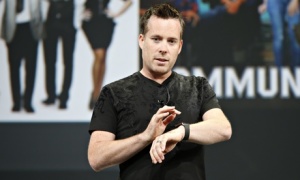In the not-too-distant future, we’ll look back at last week’s Google I/O developers conference as the day the smart watch really went mainstream. Google announced three new smart watches from LG, Samsung and Motorola that will use the new Android Wear platform. The devices from Samsung and LG are available in the Google Play store already, and the Motorola watch (which looks to be pretty stylish) will be out later this summer. While devices like the Samsung Galaxy Gear, Google Glass and the Pebble watch have been important milestones, this commitment from Google really marks the beginning of the wearable technology era. There are some very good reasons why you’ll see a lot more smart watches on the street over the next 18 to 24 months.
Dave Burke, a Google engineer, at the Google I/O developers conference. Photograph: Stephen Lam/Getty Images
The Form Factor is Right
The adoption of technology, even as its pace accelerates, seems to prefer the incremental to the revolutionary. Going from a phone on the wall to a cordless phone to a cell phone to a smart phone, while a major shift with huge implications within the space of two decades, seemed to strike people as a rather natural progression. Of course, Google has already tried something much more revolutionary than a watch with Project Glass. While that initiative may not be dead, it’s clear that consumers are far from ready to walk around with piece of technology on their faces. This natural tendency is good news for the smart watch. Most people already walk around with a little piece of technology on their wrists. The most recent product unveilings show that a smart watch can not only be unobtrusive, it can also be somewhat stylish.
The Value is There
Naturally, a huge factor in how any new technology is adopted is the balance between the costs and benefits of adoption. When Amazon’s Kindle first came out in 2007, the $399 price tag and relatively limited availability of titles were huge barriers to adoption. As competition and innovation drove the price down and the available content up, adoption rose exponentially. Smart watches seem to be on the same trajectory. Early attempts like the Galaxy Gear have had limited compatibility and functionality coupled with pretty high price tags. The devices announced last week are compatible with all phones that run a recent version of Android, and the price is already down around the $200 mark. By all accounts, Apple will announce its own smart watch in the fall, and other manufacturers are sure to line up to make more Android watches (Google announced last week at I/O that there are now one billion active Android devices out there, so companies will surely see the opportunity). This will almost certainly drive prices down even further.
Google’s new smartwatches are a step forward, but still have some way to go. Photograph: Elijah Nouvelage/Reuters
That covers the cost side of the value equation. The more important part, though, is the benefit that users will realise by adopting a smart watch. This is the main reason I see a tipping point right now. Google has been busy over the past year and a bit, curating and improving their Google Now feature. This service uses a mix of opt-in and predictive signals to push useful information to you like weather updates, traffic conditions, sports scores, reminders about TV shows, flight updates, nearby events or businesses and a whole lot more. These bite-sized, timely, contextually-aware bits of information are built for a wearable like a smartwatch that’s always on, always with you and always connected. The demos at I/O show that Now, with its card-based interface, will play a marquis role in the new Android Wear platform. I’ve been using Now on my phone for months now, and the value it provides is pretty staggering. It pulls travel reservations from my Gmail, warns me of traffic snarls, pushes me scores from my favourite teams and suggests places to eat. Having that available at a glance on my wrist without even pulling out my phone is a huge draw for me.
So, What’s a Marketer to Do?
Research firm On World predicts that more than 300 million smartwatches will be sold globally by the end of 2018. To contextualise that number a bit, fewer than 4 million were sold last year. As a marketer, that’s a pretty clear sign that a significant shift in user behaviour is on the horizon. The question is, what do you do about it?
The first step is to get your digital house in order. This seems pretty obvious, but the virtual mess that persists today is quite striking. I recently took a weekend trip to Vermont with my wife, and I was quite taken aback by how difficult it still is to find places to go and things to do in an unfamiliar place. I found incorrect website addresses in business listings, inconsistent hours of operation, menus hidden behind uncrawlable PDF’s (good luck viewing that on your phone, much less a smartwatch), events not marked up to alert search engines, and a whole heap of other frustrating digital dregs. The first step is to stop putting up digital barriers between you and your customers. How long would a business owner put up with a misspelt sign on the front of their store or a front door that will only open when customers exert a lot of effort? Yet, that’s precisely what’s going on in the digital space. With changing, technology comes changing consumer expectations, and businesses that aren’t ready for that change won’t even know what they’re missing.
The next step is to relentlessly look for opportunities to make connections with your customers. A smartwatch on someone’s wrist, just like the phone in their pocket, offers brand new opportunities for interaction with your brand. Imagine if you’re a grocery store owner and your loyalty program tells you that a customer purchased milk four days ago. Your consumer analytics tell you that consumer probably needs milk by now. Because they have your app installed and have agreed to receive notifications from you, you can flash a special deal on milk to their wrist as they walk by your store – or a competitor’s store for that matter. This is just one of a multitude of possible timely, contextually relevant and valuable consumer – targeted activations that deliver tangible mutual benefit. Finding ways to leverage what you know about your customers into valuable interactions that will deepen the connection with your brand will give you an edge in this new space.
In some ways, with the rise of mobile so fresh in our minds, it’s hard to believe that another potentially disruptive technology could be right around the corner, but that appears to be the case. Much like mobile, the marketers who get there early and exploit the possibilities quickly will reap the benefits.
Interested in finding out more? Contact DAC today!






